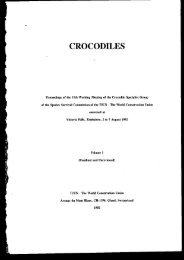size: 5405KB - Crocodile Specialist Group
size: 5405KB - Crocodile Specialist Group
size: 5405KB - Crocodile Specialist Group
Create successful ePaper yourself
Turn your PDF publications into a flip-book with our unique Google optimized e-Paper software.
The demand for crocodile skins in the 28-34 cm range can be attributed to skins being purchased by<br />
the ailing ostrich industry in an effort to increase their product offering and to justify keeping their<br />
tanneries open. Increased demand for quality large skins has also resulted in a number of farms<br />
going the single-pen route, despite the negative publicity in South Africa regarding single pen<br />
rearing. The South African NSPCA has called for a ban on this practice. A Standard for the keeping<br />
of crocodiles in South Africa (SANS 631 of 2010) is available online at<br />
https://law.resource.org/pub/za/ibr/za.sans.631.2009.pdf.<br />
There are efforts in South Africa to revive the SA <strong>Crocodile</strong> Farmers Association (SACFA) - the<br />
chairman of SACFA resigned in 2012, whereupon the SACFA Executive suspended its activities.<br />
The aim is to reconstitute the Association during 2013.<br />
NAMIBIA<br />
Howard Kelly reports that an evaluation of the status of wild Nile <strong>Crocodile</strong>s in Namibia was<br />
carried out for the Namibian Government in 2012. One of the recommendations in the report called<br />
for an immediate completion of the Namibian <strong>Crocodile</strong> Management Plan. The purpose of this<br />
investigation was to ascertain whether the wild crocodile populations in the four ‘Caprivi rivers’<br />
could support a commercial venture in the region. The initiative was undertaken by the Ministry of<br />
Trade and was partially driven by concerns regarding the social and economic conditions in the<br />
Caprivi region; there is extensive poverty and HCC is a serious issue. A business model is currently<br />
under assessment and highlights that the Nile crocodile is a keystone species for the region with the<br />
potential to act as a catalyst for real socio-economic change. The Environmental Impact Assessment<br />
for the initiative should be finalised by mid-2013.<br />
MALAWI<br />
A social survey has been carried out in TA Pemba and Maganga’s areas in Salima District, which<br />
showed that HCC is a real disaster risk in the areas. Structures in place to reduce the risk of HCC<br />
are deemed to be ‘weak’. Trophy hunting was authorised by the Department of National Parks and<br />
Wildlife (DNPW) in 2010, with a quota of 15 wild crocodiles in 2012.<br />
Alison Leslie and a PhD student are planning a new crocodile research project for Malawi entitled:<br />
“Population status, levels and trends of the Nile crocodile in a human conflicted environment along<br />
the Lower Shire River”. This project will include the lower portion of the Shire River and the wellknown<br />
elephant marsh area. <strong>Crocodile</strong>s in this area are said to be under-nourished due to the lack of<br />
prey as a result of conflict with humans. It is hoped that the project will commence in the early<br />
stages of 2014.<br />
BOTSWANA<br />
Vince Shacks and Sven Bourquin are continuing with the Okavango <strong>Crocodile</strong> Monitoring project<br />
with a study on the “Baseline Levels of Persistent Organic Pollutants (POPs) in <strong>Crocodile</strong>s of the<br />
Okavango Delta, Botswana”.<br />
UGANDA<br />
At CoP16 in Bangkok, March 2013, the status of a research project being undertaken at Murchison<br />
Falls was discussed with members of the Ugandan delegation. The CSG was thanked for providing<br />
“crocodilian” literature, which greatly assisted the researchers in that country.

















